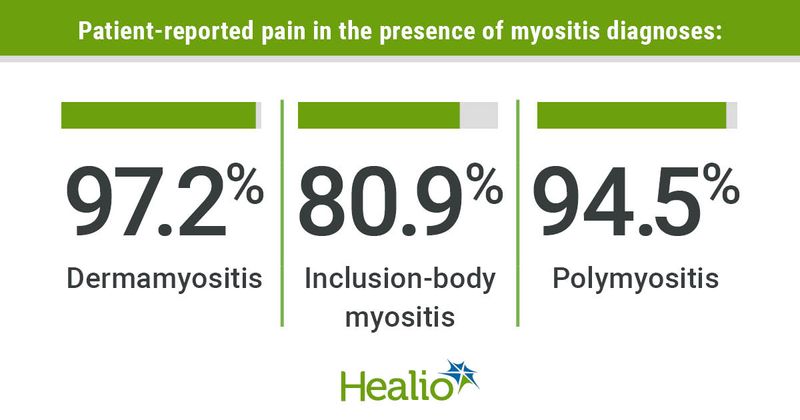Myositis pain strategies ‘not uniform,’ require ‘multiple modalities’
Click Here to Manage Email Alerts
Among patients with myositis, younger individuals with dermatomyositis are more likely to experience pain, while those with polymyositis are more likely to receive opioids, according to data published in Rheumatology.
The researchers added that pain should be a priority when treating patients with myositis, but more studies are needed to better understand effective treatment avenues.

“Despite the importance of pain as a domain of myositis, it is generally agreed that the prevalence of pain in myositis is unclear and pain management is often heterogeneous,” Abhiram Bhashyam, MD, PhD, of the department of orthopedics at Massachusetts General Hospital, and study co-authors wrote. “In contrast, in other [mixed connective tissue diseases (MCTDs)], pain and its impact are better explored. In these conditions and in myositis, pain treatment is inadequate and requires greater attention to help address impact on physical functioning and quality of life.
“Given the need for a better understanding of pain in myositis, Myositis Support and Understanding (MSU), a non-profit, patient-led advocacy organization for myositis, prioritized understanding and addressing pain in myositis,” they added. “Leadership and members of MSU identified pain as a key domain that needed further exploration, which served as the motivation for the survey.”
To analyze prevalence of pain among varying subtypes of myositis, as well as the frequency of opioid use for pain among patients, Bhashyam and colleagues developed an anonymous survey administered to MSU members. In all, 468 respondents completed the survey between May 2019 and June 2019. Patients were eligible for inclusion if they were older than 18 years or had a confirmed inflammatory myopathy diagnosis. Patients with juvenile dermatomyositis, mixed connective tissue disease, necrotizing autoimmune myopathy or orbital myositis were excluded.
The survey included questions to catalogue details such as demographics, confirmed diagnoses, age, sex and time since diagnosis. Patients indicated on the survey whether they have ever had pain, and whether that pain was primary or secondary to myositis. Finally, patients reported whether they took pain medicines, whether those medications were opioids, and the specific names of the pain medications.
A total of 423 patients were included for final analysis. More than 90% of patients with myositis reported current or past pain and 99% of those attributed the pain to myositis, according to the researchers. There was a lower chance of pain in patients aged older than 60 years (OR = 0.2; 95% CI, 0.1-0.6). Patients with dermatomyositis reported the most pain (97.2%), followed by polymyositis (94.5%) and inclusion-body myositis (80.9%). There were higher risks for pain in patients with dermatomyositis compared with inclusion-body myositis (OR = 3.7; 95% CI, 1.3-10.2).
According to the researchers, 335 of the 387 patients who reported pain also reported medication use. Among these patients, more than two-thirds (69%) reported being prescribed opioids.
“Younger participants and those with [dermatomyositis (DM)] are more likely to experience pain, but a diagnosis of [polymyositis (PM)] is more highly associated with use of opioids,” Bhashyam and colleagues wrote. “Treatment strategies are not uniform and likely require multiple modalities of therapy to alleviate pain. Future studies should prospectively investigate pain in myositis, its impact on quality of life, and the most effective treatment options.”
